Introduction to Brilinta (Ticagrelor)
Overview of Brilinta as an antiplatelet medication
Brilinta, known generically as ticagrelor, is a potent antiplatelet drug. It is primarily prescribed to reduce thrombotic cardiovascular events. By regulating platelet activity, it prevents excessive clot formation, which can otherwise obstruct critical blood flow. Patients with coronary artery complications often rely on Brilinta as part of a long-term therapeutic regimen.
Importance in cardiovascular disease management
Cardiovascular diseases remain the leading cause of mortality worldwide. Antiplatelet therapy forms the cornerstone of secondary prevention strategies. Brilinta plays a pivotal role by reducing recurrence of myocardial infarction and by ensuring smoother vascular function in post-ACS patients. Its rapid onset of action offers an edge over older agents.
FDA and EMA approval status
The U.S. Food and Drug Administration (FDA) and the European Medicines Agency (EMA) have both endorsed ticagrelor for use in patients with acute coronary syndromes. Its global approval underscores its clinical efficacy and safety profile, validated through extensive randomized controlled trials.
Composition and Formulations
Active ingredient: Ticagrelor
Ticagrelor serves as the active moiety, exerting direct pharmacological action at the P2Y12 receptor site. It belongs to the cyclopentyltriazolopyrimidine chemical class.
Available dosage strengths and forms (tablets, film-coated)
Brilinta is distributed as film-coated tablets. Dosage strengths include 60 mg and 90 mg tablets, tailored for initial and maintenance phases of treatment.
Inactive ingredients and excipients
Inactive constituents typically comprise microcrystalline cellulose, mannitol, magnesium stearate, and coloring agents for film coating. These components ensure stability, palatability, and bioavailability.
Brilinta vs plavix
Brilinta is generally more effective but carries a higher bleeding risk than Plavix, which is more affordable and has a generic form. Brilinta is a faster-acting, direct-acting antiplatelet drug (ticagrelor), while Plavix (clopidogrel) requires liver activation and may be less effective for "poor metabolizers" with certain genetic factors. Brilinta also causes more shortness of breath.
Eliquis vs brilinta
Eliquis (apixaban) is a blood thinner that prevents clot formation by blocking factor Xa, while Brilinta (ticagrelor) is an antiplatelet that stops platelets from clumping. Eliquis is used for atrial fibrillation and DVT, whereas Brilinta is used for acute coronary syndrome and stroke prevention after specific heart events.
Brilinta vs heparin
Brilinta (ticagrelor) is an oral antiplatelet medication that prevents platelets from clumping, while Heparin is an injectable anticoagulant that slows the body's clotting process. They belong to different drug classes, are taken by different methods (by mouth vs. injection), and are used in different clinical situations, although they are both used to treat blood clot-related cardiovascular events and can be used together under a doctor's supervision.
Brilinta vs clopidogrel
Brilinta (ticagrelor) and clopidogrel (Plavix) are antiplatelet medications used to prevent blood clots, but Brilinta is a more potent and faster-acting option than Plavix, particularly in patients with acute coronary syndrome (ACS). While Brilinta shows superior efficacy in reducing cardiovascular events, it also carries a greater risk of bleeding, which can be a significant factor in choosing between the two drugs. Clopidogrel requires liver activation to work, making it less suitable for certain patients who have difficulty with CYP2C19 enzymes, whereas Brilinta does not need this activation.
Brilinta Mechanism of Action
Ticagrelor as a P2Y12 receptor antagonist
Ticagrelor selectively binds to P2Y12 receptors located on platelet membranes. Unlike prodrugs such as clopidogrel, it exerts activity without metabolic activation.
Inhibition of platelet activation and aggregation
By preventing adenosine diphosphate (ADP) from activating platelets, Brilinta diminishes platelet aggregation. This reduces the likelihood of arterial occlusion, especially after plaque rupture.
Comparison with clopidogrel and prasugrel
- Clopidogrel requires hepatic activation, whereas Brilinta does not.
- Prasugrel exhibits irreversible binding, while ticagrelor is reversible.
- Clinical outcomes suggest ticagrelor offers faster, more consistent platelet inhibition.
Impact on thrombotic risk reduction
Through this mechanism, Brilinta reduces thrombotic risk across a spectrum of cardiovascular conditions, particularly during the high-risk post-infarction period.
Brilinta Uses
Brilinta for Acute Coronary Syndrome (ACS)
- Use in unstable angina: Prevents progression to infarction by stabilizing platelet activity.
- Use in NSTEMI: Reduces recurrent ischemic episodes and improves vascular outcomes.
- Use in STEMI: Supports reperfusion therapy and prevents reinfarction following thrombolysis or PCI.
Brilinta for Percutaneous Coronary Intervention (PCI)
- Prevention of stent thrombosis: Critical in maintaining patency of coronary stents.
- Dual antiplatelet therapy with aspirin: Proven synergistic effect in reducing post-PCI complications.
Brilinta for Secondary Prevention
- Prevention of cardiovascular death, myocardial infarction, or stroke: Especially in high-risk individuals with previous infarction.
- Long-term use after ACS: Reduces the likelihood of recurrent ischemic events.
Off-Label Uses of Brilinta
- Peripheral artery disease (PAD): May improve outcomes by reducing limb ischemia events.
- Stroke prevention: Used in certain cases of non-cardioembolic ischemic stroke and transient ischemic attack.
- COVID-19-related thrombosis: Investigated for reducing thromboembolic complications in severe cases.
- Atrial fibrillation patients intolerant to anticoagulants: Considered where warfarin or DOACs are contraindicated.
Brilinta Dosage and Administration Guidelines
- Brilinta dose and maintenance: Initiation with a 180 mg loading dose, followed by 90 mg twice daily.
- ACS patients: Loading dose critical at onset of therapy.
- Co-administration with aspirin: Low-dose aspirin (75–100 mg daily) enhances therapeutic effect.
- Adjustments for special populations: Dose modifications generally unnecessary, but caution is warranted in hepatic impairment.
- Administration: Can be ingested with or without meals.
Important Precautions and Safety Considerations
- Risk of bleeding: Hemorrhagic complications represent the most significant safety concern.
- Monitoring: Clinical vigilance for signs of bleeding and arrhythmias is recommended.
- Duration of therapy: Typically up to 12 months post-ACS, with extended therapy based on patient profile.
- Switching therapy: Transition to or from other antiplatelet agents must be carefully timed to avoid gaps in coverage.
- foods to avoid while taking brilinta: grapefruit and grapefruit juicelarge quantities of garlic, ginger, or dark chocolate, as well as alcohol,
- brilinta alternatives: clopidogrel (Plavix)prasugrel (Effient)dipyridamole (Persantine)dipyridamole/aspirin (Aggrenox)ticlopidine.eptifibatide.warfarin (Jantoven)heparin.
- brilinta and alcohol: Alcohol use should be limited while using Brilinta. Mixing alcohol and Brilinta could lead to increased dizziness. Someone using alcohol while taking Brilinta should speak with their doctor about the risks that are specific to their situation.
- brilinta reversal agentI: The reversal agent for Brilinta (ticagrelor) is bentracimab, an investigational, recombinant monoclonal antibody fragment designed to bind to and neutralize ticagrelor and its active metabolite, rapidly reversing the antiplatelet effects of the drug.
Brilinta Contraindications
- Hypersensitivity to ticagrelor or its excipients.
- Active pathological bleeding.
- History of intracranial hemorrhage.
- Severe hepatic impairment with risk of accumulation.
Careful Administration and Warnings
- Moderate hepatic impairment: Use with caution; metabolism may be compromised.
- Renal impairment: While no dose adjustment is mandated, increased surveillance is necessary.
- Surgical candidates: Discontinue at least 5 days prior to elective surgery to reduce bleeding risk.
- Dyspnea: Transient shortness of breath may prompt discontinuation in some patients.
- Drug interactions: Potent CYP3A4 modulators alter therapeutic levels significantly.
Brilinta Side Effects
Common Side Effects
- Dyspnea and shortness of breath.
- Headache, dizziness, nausea.
- Minor bleeding: epistaxis, easy bruising.
- Gastrointestinal discomfort.
Long-term Effects of Brilinta
- Major bleeding events, including gastrointestinal and intracranial hemorrhage.
- Bradyarrhythmias and heart block requiring medical intervention.
- Hypersensitivity reactions ranging from rash to anaphylaxis.
Drug Interactions with Brilinta
Interaction with CYP3A4 inhibitors (ketoconazole, clarithromycin)
Brilinta is metabolized via the cytochrome P450 3A4 pathway. Strong inhibitors such as ketoconazole or clarithromycin significantly increase plasma concentrations of ticagrelor. This can intensify pharmacodynamic activity and amplify bleeding tendencies. Co-administration is generally discouraged to avoid exaggerated antiplatelet responses.
Interaction with CYP3A4 inducers (rifampin, phenytoin)
CYP3A4 inducers including rifampin and phenytoin accelerate ticagrelor metabolism. This leads to diminished therapeutic effect and suboptimal platelet inhibition. Clinicians often substitute alternative therapies rather than risk inadequate cardiovascular protection.
Interaction with digoxin and statins
Ticagrelor can elevate serum digoxin concentrations by inhibiting P-glycoprotein transport. Statins metabolized via CYP3A4, such as simvastatin and lovastatin, may also rise to supratherapeutic levels. Careful dosage adjustments or switching to non-CYP3A4 substrates like pravastatin are prudent strategies.
Risks with concurrent anticoagulant therapy
Combining Brilinta with anticoagulants such as warfarin or direct oral anticoagulants markedly increases hemorrhagic risk. The overlap of antiplatelet and anticoagulant effects can precipitate catastrophic bleeding episodes. Dual or triple therapy is reserved for highly specific clinical scenarios under vigilant monitoring.
Administration in Special Populations
Administration in Elderly Patients
In patients over 65 and especially beyond 75 years, Brilinta maintains efficacy, but susceptibility to bleeding rises. Frailty, polypharmacy, and comorbidities intensify this risk. Regular surveillance is indispensable.
- Assess for unexplained bruising or occult bleeding.
- Routine hemoglobin and hematocrit checks.
- Adjustment of concomitant drugs to reduce cumulative bleeding risk.
Administration in Pregnant Women and Nursing Mothers
Ticagrelor is classified as pregnancy category C, meaning animal studies revealed adverse effects on fetal development, yet human data remain insufficient. Use should be confined to circumstances where maternal benefit surpasses fetal risk.
- Potential risk to fetus: Teratogenicity cannot be excluded; cautious evaluation is warranted.
- Excretion in breast milk: Available data suggest ticagrelor and its metabolites may appear in milk, potentially affecting the nursing infant.
- Recommendation: Discontinuation of breastfeeding or substitution of therapy may be necessary.
Administration in Children
Safety and efficacy in pediatric cohorts are not established. Clinical trial data remain sparse, offering no substantial guidance. Until validated evidence emerges, Brilinta is not recommended for children or adolescents.
Overdosage of Brilinta
Symptoms and risks associated with overdose
Excessive ingestion of ticagrelor magnifies bleeding risk, leading to potential gastrointestinal hemorrhage or intracranial events. Dyspnea, profound fatigue, and arrhythmias may accompany overdose scenarios.
Management of bleeding in overdose situations
No specific antidote exists. Supportive measures constitute the cornerstone of therapy.
- Immediate discontinuation of the drug.
- Local hemostatic interventions for visible bleeding.
- Transfusion of platelets in severe or refractory cases.
Supportive treatment and monitoring guidelines
Continuous cardiovascular and hematologic monitoring is mandated. Renal and hepatic function should be observed to gauge drug clearance capacity. Hospital-based supportive care ensures rapid intervention in life-threatening events.
Handling and Storage Precautions
Recommended storage conditions (temperature, humidity)
Brilinta should be stored at controlled room temperature, ideally between 20°C and 25°C. Exposure to excessive humidity and heat should be avoided to maintain drug potency.
Safe handling instructions for patients and caregivers
Tablets should remain in their original packaging until administration. Crushing or splitting is not recommended unless specifically instructed by a healthcare provider. Keep out of reach of children to prevent accidental ingestion.
Shelf life and stability considerations
Each package contains a labeled expiration date, beyond which stability and efficacy cannot be guaranteed. Proper storage conditions ensure optimal shelf life and therapeutic reliability.
Brilinta Nursing Considerations
Assess patient for symptoms of stroke, peripheral vascular disease, or MI periodically during therapy. Observe patient for signs and symptoms of hypersensitivity reactions (rash, facial swelling, pruritus, laryngeal edema, wheezing). Discontinue drug and notify health care professional immediately if symptoms occur.
Conclusion
Summary of Brilinta’s role in cardiovascular disease management
Brilinta stands as a cornerstone in preventing recurrent thrombotic episodes among patients with acute coronary syndromes. Its reversible, potent inhibition of platelet aggregation provides reliable vascular protection.
Balancing benefits against bleeding risk
While highly effective, Brilinta’s clinical success hinges on judicious patient selection. The balance between ischemic protection and bleeding propensity remains central to therapeutic decision-making.
Importance of physician guidance and adherence to therapy
Patient adherence, coupled with professional supervision, determines therapeutic outcomes. Proper counseling, vigilant monitoring, and individualized care sustain Brilinta’s benefits while minimizing complications.
Brilinta, Ticagrelor FAQ
- Is Brilinta a blood thinner or antiplatelet?
- What is Brilinta tablet used for?
- Is Brilinta the same as Plavix?
- Is Brilinta the same as eliquis?
- When can I stop taking Brilinta after a stent?
- Is Brilinta safe for kidneys?
- What should I avoid while taking Brilinta?
- Which is better, Brilinta or aspirin?
- Why does Brilinta cause shortness of breath?
- Can you be on both Brilinta and Eliquis?
- What is a good substitute for Brilinta?
- What happens if you take too much Brilinta?
- Is BRILINTA a high-risk medication?
- How long should a person be on Brilinta?
- Can Brilinta make you tired?
- What foods should you avoid while taking Brilinta?
- Does Medicare cover Brilinta?
- Is Brilinta bad for your liver?
- Can you drink coffee while taking Brilinta?
- Can I take vitamin D with Brilinta?
- What is a good alternative to Brilinta?
- Can Brilinta be cut in half?
- What if I miss my Brilinta?
- Why Brilinta after heart cath?
- Can I take Brilinta and atorvastatin together?
- Can I take CoQ10 with Brilinta?
- What are the side effects of Brilinta for the elderly?
- What happens after you stop taking Brilinta?
- Is Brilinta generic now?
- Can I have a glass of wine while taking Brilinta?
- What foods should you not eat while taking Brilinta?
- Can I take Brilinta for life?
- Does BRILINTA shortness of breath go away?
- What is the ticagrelor drug used for?
- What are the main side effects of ticagrelor?
- How long to take ticagrelor after stent?
- Why do you stop taking ticagrelor after a year?
- Is it safe to take ticagrelor long term?
- Is Brilinta a blood thinner or antiplatelet?
- What is Brilinta tablet used for?
- Can I take CoQ10 with Brilinta?
- How long should you take Brilinta after a stent?
- Is BRILINTA a high-risk medication?
- What is the ticagrelor drug used for?
Is Brilinta a blood thinner or antiplatelet?
Brilinta is classified as a blood thinner. It's an antiplatelet medication that functions by preventing the activation of your platelets. Platelets are cells that adhere to one another and create clots. Therefore, by inhibiting the activation of these cells, Brilinta helps keep your blood thin and free from clots.
What is Brilinta tablet used for?
Brilinta 90mg Tablet is an antiplatelet medication, commonly known as a blood thinner. It inhibits blood clotting within the veins and arteries, allowing blood to circulate freely throughout your body and reducing the risk of a heart attack or stroke (deep vein thrombosis or pulmonary embolism).
Is Brilinta the same as Plavix?
Brilinta (ticagrelor) and Plavix (clopidogrel) are antiplatelet drugs used to prevent blood clots. Brilinta is taken twice daily, while Plavix is taken once daily. They are frequently used alongside low-dose aspirin. Both Brilinta and Plavix effectively prevent blood clots.
Is Brilinta the same as eliquis?
Eliquis is a direct-acting oral anticoagulant (DOAC) that inhibits factor Xa to prevent clot formation, whereas Brilinta is an antiplatelet drug that prevents platelets from aggregating.
When can I stop taking Brilinta after a stent?
6-12 months
Is Brilinta safe for kidneys?
Brilinta does pose a risk of harming the kidneys and leading to acute kidney injury.
What should I avoid while taking Brilinta?
Alcohol
Which is better, Brilinta or aspirin?
Aspirin
Why does Brilinta cause shortness of breath?
An elevated concentration of adenosine may activate pulmonary vagal C fibers, resulting in the feeling of dyspnea
Can you be on both Brilinta and Eliquis?
Using apixaban in combination with ticagrelor may elevate the risk of bleeding, which can include severe and occasionally life-threatening hemorrhage
What is a good substitute for Brilinta?
What happens if you take too much Brilinta?
- Gum bleeding
- Shortness of breath
Is BRILINTA a high-risk medication?
Brilinta (along with similar medications) can result in bleeding that may be severe and, at times, fatal. Cases of significant bleeding, like internal bleeding, might necessitate transfusions or surgical intervention.
How long should a person be on Brilinta?
6-12 months
Can Brilinta make you tired?
No
What foods should you avoid while taking Brilinta?
Grapefruit or grapefruit juice
Does Medicare cover Brilinta?
Yes
Is Brilinta bad for your liver?
Brilinta is not recommended for individuals with serious liver issues.
Can you drink coffee while taking Brilinta?
Yes
Can I take vitamin D with Brilinta?
Yes
What is a good alternative to Brilinta?
- clopidogrel (Plavix)
- prasugrel (Effient)
- dipyridamole (Persantine)
- dipyridamole/aspirin (Aggrenox)
- ticlopidine
- eptifibatide
- warfarin (Jantoven)
- heparin
Can Brilinta be cut in half?
Yes
What if I miss my Brilinta?
If you miss a dose of Brilinta, take your next dose as scheduled. Avoid doubling up on the dose to compensate for the one you missed. Even if you've missed two doses of Brilinta, make sure to take just one dose at your next scheduled time. Taking double doses will heighten your risk of experiencing mild and severe side effects.
Why Brilinta after heart cath?
Brilinta is approved to lower the risk of cardiovascular death, myocardial infarction (MI), and stroke in patients experiencing acute coronary syndrome (ACS) or those with a prior history of myocardial infarction.
Can I take Brilinta and atorvastatin together?
Yes
Can I take CoQ10 with Brilinta?
Yes
What are the side effects of Brilinta for the elderly?
- Bleeding
- Shortness of breath
What happens after you stop taking Brilinta?
Blood clots can develop and lead to a stroke, heart attack, or other severe complications.
Is Brilinta generic now?
Yes
Can I have a glass of wine while taking Brilinta?
No
What foods should you not eat while taking Brilinta?
There are no foods you need to steer clear of while you're using it.
Can I take Brilinta for life?
Yes
Does BRILINTA shortness of breath go away?
Yes
What is the ticagrelor drug used for?
Ticagrelor is utilized to lower the risk of heart attack or stroke in specific high-risk patients. It is also employed to minimize the risk of blood clots in certain high-risk individuals.
What are the main side effects of ticagrelor?
- Bleeding more easily than usual
- Unanticipated shortness of breath while at rest
- Pain and swelling in your joints
- Headaches
- Feeling lightheaded
- Experiencing nausea
- Indigestion
- Diarrhea
How long to take ticagrelor after stent?
At least 12 months
Why do you stop taking ticagrelor after a year?
The likelihood of a clot developing is significantly reduced after the initial year.
Is it safe to take ticagrelor long term?
Yes
Is Brilinta a blood thinner or antiplatelet?
Brilinta is viewed as a blood thinner. It’s an antiplatelet medication that prevents the activation of your platelets. Platelets are cells that clump together to form clots. By inhibiting the activation of these cells, Brilinta helps maintain thin blood and reduces the risk of clots.
What is Brilinta tablet used for?
Brilinta 90mg Tablet is an antiplatelet medication, commonly known as a blood thinner. It works by preventing blood from clotting within the veins and arteries, allowing blood to circulate smoothly throughout your body and reducing the risk of a heart attack or stroke (including deep vein thrombosis or pulmonary embolism).
Can I take CoQ10 with Brilinta?
Yes
How long should you take Brilinta after a stent?
6-12 months
Is BRILINTA a high-risk medication?
Brilinta (and similar medications) can result in bleeding that may be severe and, in some cases, fatal. Cases of significant bleeding, like internal bleeding, might necessitate transfusions or surgical intervention.
What is the ticagrelor drug used for?
Ticagrelor is employed to lower the risk of heart attack or stroke in specific high-risk patients. It is also utilized to decrease the risk of blood clots in certain high-risk patients.














